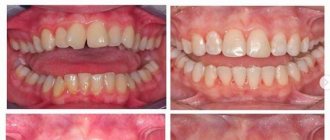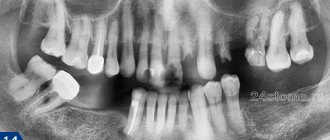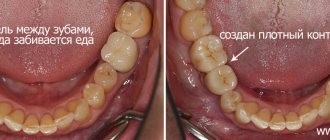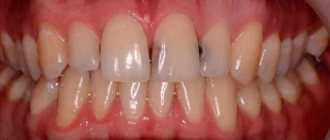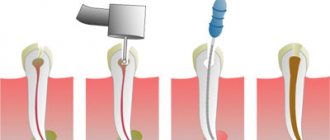According to statistics, every fifth person on the planet suffers from diastema - a gap between the front teeth. This is considered normal, especially if the cleft is small. But both large and small diastemas often become the causes of complexes and even various dental problems. Therefore, it is advisable for everyone who has a gap between their incisors to visit an orthodontist and find out from him how to remove gap between front teeth. Most often, treatment does not take much time, although it does require some investment.
Interestingly, a gap between teeth is considered a sign of creativity and significant talent. Some say that a man with a gap between his incisors is distinguished by a kind and cheerful disposition, and a woman with such a feature of appearance is prone to romantic love. Also, those with a small distance between their teeth are credited with special sensuality and the ability to enjoy the little things.
What is the correct name for the gap between the front teeth?
The correct name for the gap between the front teeth is diastema, which goes back to the Greek word diástema (Greek διαστημα). The term means "distance", "span" or "interval". Although in Greece the word was used without reference to dental disease, today diastema refers specifically to a dental problem.
A more simplified, but also correct name for the gap between the teeth is a gap or chip. This word is used primarily in literary language and works of art. But no matter what you call the problem, it still needs to be treated: although diastema is not the most unpleasant dental pathology, it remains a defect that can cause a number of dental problems.
Why does a gap appear between the front teeth?
To understand how to remove the gap between the incisors, you need to understand the causes of this problem. In some cases, diastema is a variant of the norm; it develops if a person grows small teeth with wide upper gums. It is not necessary to fix a small neat gap, as it is more of an aesthetic problem. It is usually hereditary.
This pathology can also occur due to the following reasons:
- too late or early change of teeth;
- congenital absence of one or more teeth (edentia);
- anomaly in the shape or size of the incisors;
- tongue frenulum too low.
Sometimes diastema occurs due to bad habits of chewing pens, pencils and other objects. In adults, a problem arises when the upper molars are lost: the human body is designed in such a way that when a void forms between the teeth, the remaining elements try to fill it, so the molars, incisors and canines diverge slightly and move. This happens very slowly, but eventually sometimes leads to the formation of gaps between the teeth.
Another cause of diastema is severe malocclusion and crooked teeth. Sometimes, if treated incorrectly, the incisors do not fit into place quite correctly, leaving a gap. In this case, it is necessary to continue visiting the orthodontist and complete the adjustment of the dentition.
You can read more about changes in bite and dental anomalies in a separate article on our website: All about bite: what it is like, why it is important to monitor it and how to treat improperly grown teeth.
Is it possible to get rid of gaps between teeth?
If you have diastema, you should definitely visit an orthodontist, since getting rid of gaps in your teeth is not only possible, but also necessary. Modern treatment methods make it possible to cope with such a problem quite quickly, and dentists offer a large selection of methods for hiding the gap.
The only situation where treatment is not required is diastema on baby teeth in children. This is considered normal and does not require medical intervention. Over time, when the bite changes, the teeth take on the correct position on their own.
A small diastema on baby teeth is normal.
Mechanism of development of gaps
The development of teeth and their location in the dentition is influenced by a large number of factors. This includes genetics and various external influences. The most significant factors include:
- violation of the deadlines for replacing milk teeth with permanent ones;
- untimely loss of baby teeth;
- short frenulum of the upper lip;
- displacement of teeth in the dentition due to loss or absence of tooth eruption;
- excessive growth of bone tissue of the palate;
- excess number of teeth in the dentition;
- insufficient width of the crowns of the teeth in relation to the length of the jaw;
- bad dental habits: chewing a pen, holding a pencil or other objects in your teeth;
- jaw injuries.
Types of diastemas
There are many types of diastemas. They are mainly classified according to the following features:
- False or true. False diastema occurs in children and is considered a type of normal. It disappears on its own after changing the bite. The teeth are not harmed. True diastema is permanent and requires treatment.
- Symmetry. There is a symmetrical cleft, in which the incisors have the same shift relative to each other, and an asymmetrical one, when one of the front teeth occupies the correct position, and the second is shifted. The latter is the most dangerous, because it disrupts the correctness of the dentition.
- Direction of the vertical axis of the incisors. It can be lateral, when the roots are parallel and the crowns diverge, corpus, if the tooth moves along with the root, and medial, when the incisors grow to the side or rotate around their axis.
False and small symmetrical diastemas are practically safe. The first will disappear on its own, the second is just a cosmetic defect. If the position of the tooth root is disturbed or the gap between the incisors is too large, it is better to consider treatment options.
Use of artistic restoration
Some patients are advised to undergo aesthetic artistic dental restoration to eliminate diastema. This is a therapeutic intervention during which composite microprostheses (veneers) are installed on the two central incisors, between which there is a gap. The doctor uses a filling material that matches the patient’s natural enamel shade and builds up additional volume of hard tissue on the two central front teeth. To undergo this procedure, you only need to visit the clinic once.
When restoring a tooth, the doctor restores its shape and function. The presence of colored deposits and cracks in the enamel, and other signs of destruction of dental tissue does not play any role, since most of the visible dental tissue is removed. Then its natural shape, color and functional properties are formed using composite materials (build-up method). If the root of a tooth is damaged, it is treated first, and restoration is carried out only at the next stage. If no pathologies associated with the tooth root are detected, then in 5-6 hours a qualified doctor is able to restore at least 4-5 teeth. However, if the dentist first works with the root of the tooth, then further manipulations are carried out after at least two days.
An important advantage of artistic restoration is its complete painlessness. Another important advantage of this method is its safety, therefore it has a minimal list of contraindications. Dental restoration can be performed on women even during pregnancy.
Ways to correct gaps between teeth
The choice of treatment for diastema depends on the reasons for its development, the size of the gap, the characteristics of the patient’s jaw and his budget. The doctor also assesses the patient’s age and the condition of the dentition. All methods can be divided into cosmetic (hiding the problem) and therapeutic (changing the position of the teeth using correction tools). Let's consider the features of each method separately.
Braces
Installing braces is a classic way to eliminate dental deficiencies. They are a non-removable orthodontic structure that is attached to the teeth for a significant period. A variety of braces can eliminate even complex malocclusions, which makes such systems very versatile. During the existence of braces, several varieties of these orthodontic devices have appeared:
- Metal. The most popular and cheapest type of braces. They have a medium size and high efficiency, at a fairly affordable price. Very noticeable on teeth.
- Plastic. They look more aesthetically pleasing than metal ones and do not damage the enamel as much, but when wearing them you should not drink coffee, tea or products that color plastic, as it absorbs the colors.
- Ceramic. The most expensive and beautiful option of braces. They are completely safe, do not change color, and are almost invisible on the teeth.
- Sapphire. They belong to the ceramic group, but require less wearing time than classic models.
There are also gold braces - a premium treatment system, fancy and expensive, and various variations of plastic, metal, ceramics, for example, models with colored ligatures or overlays in the form of hearts, stars and other figures.
Appearance of different types of braces
The maximum effectiveness is shown by wearing braces at the age of 16 to 20 years, when the dentition has already completely changed, but remains quite mobile, because the bone tissue of the jaw is not fully formed. Treatment at this age gives stable and long-lasting results.
The main advantages of braces systems are:
- high efficiency;
- comparative safety;
- the ability to install a hidden bite correction system.
This method of treatment also has disadvantages, namely:
- long wearing period (from one year to 3 years);
- high cost of aesthetic types (sapphire, lingual);
- the need for specialized care, otherwise the risk of developing caries increases;
- Constant wear; braces cannot be removed for an event or during a trip.
Records
The principle of operation of the plate is similar to braces, but it looks different and can be removed from the teeth for a short time. The plates work best at an early age - up to 12 years. At this time, the bone tissue of the jaw is still soft, so the position of the teeth is easy to correct.
Plates for correcting bite
The advantages of records are:
- safety of treatment;
- high efficiency;
- the ability not to wear the product all the time;
Disadvantages of the system:
- may cause discomfort when wearing;
- not suitable for correcting serious defects.
Mouthguards
Mouthguards are orthodontic devices that are placed on the teeth, somewhat reminiscent of covers. They are made specifically for the patient using 3D technology and are sent as a set after taking measurements. The idea is to wear covers that put a little pressure on the teeth at first, then more and more even variations. As a result, the cutters snap into place under plastic pressure.
Transparent aligners are invisible on the teeth
The advantages of mouth guards are:
- ease of maintenance of plastic structures;
- comparative invisibility;
- high efficiency and the ability to simultaneously correct other malocclusions.
Disadvantages of this type of treatment:
- transparent aged aligners are still visible on the teeth and attract attention;
- the patient must strictly adhere to the wearing regime, otherwise the entire set of covers will have to be completely remade (they are made at one time).
Veneers and Lumineers
Veneers are microprostheses that are placed on the outer surface of the tooth. They hide the incisor and allow you to close the gap. Lumineers are made in much the same way as veneers, but they are much thinner and more discreet. Both types of onlays are made from modern materials that closely resemble real teeth, do not change over time and do not cause allergies.
Advantages of veneers and lumineers:
- quick effect, literally in 1-2 doses;
- durability of the onlays (veneers last 10 years, lumineers - about 20);
- impeccable appearance.
Disadvantages of products:
- there are contraindications, for example, veneers and lumineers cannot be placed if a person suffers from bruxism or increased tooth wear;
- cannot be used during an extreme lifestyle (the microprosthesis may fall off).
Veneers, unlike lumineers, have another significant drawback - teeth are ground down to fit them. Lumineers only affect the top layer of enamel, but their price is much higher.
Crowns
When treating diastema in adults, doctors often recommend installing crowns. These permanent structures completely cover the incisor, hiding the gap. At the same time, installing a crown completely restores the functionality of the tooth. True, it has to be sharpened. But, if the incisor has already suffered, for example, it has chipped or been susceptible to caries, this type of treatment is quite justified.
When installing a crown, grinding of the tooth is used
When installing a crown, it is very important to choose the right material. Until recently, there was only one option - metal, most often gold. The cheapest, but also the most visible type of crown. Today it is possible to install products that are very similar to real teeth, for example, ceramic (made of porcelain, aluminum oxide, zirconium dioxide) or metal-plastic. The latter are the cheapest, but can cause irritation to the delicate mucous membranes.
Advantages of crowns:
- safe and effective method;
- you can protect damaged teeth;
- lasts 10-20 years;
- result after several visits to the dentist.
Flaws:
- grinding of the tooth is required, which is unreasonable to do on healthy incisors;
- A crown made of high-quality materials is an expensive solution.
Implants
An implant is an artificial tooth that is mounted on a metal pin secured inside the jawbone. This is the most expensive and highest quality method of restoring teeth if their roots have died and are not preserved. When implants are installed, the functionality of the incisor is completely restored. The pins themselves are made primarily of titanium and are divided by type (each for its own type of tooth: molar, incisor, canine). Crowns can be made from different materials, but metal-ceramics are the most popular, since they stand out the least in the dentition.
Blank for implant installation
The advantages of installing an implant are:
- the effectiveness of the procedure for tooth restoration;
- quick visible results;
- service life is lifelong.
Disadvantages of technology:
- implantation is an operation that requires appropriate preparation;
- it is not always possible to insert a pin into the bone (it may be too thin);
- You will always have a permanent piece of metal with you, this causes certain problems (increased attention from security, inability to undergo an MRI, etc.).
Cosmetic correction
Cosmetic correction is the hiding of the diastema by forming a small filling attached to the sides of the incisors. Essentially, the specialist covers the gap with filling material. This is the simplest and cheapest method that does not harm the teeth.
Advantages:
- harmlessness with high efficiency;
- visible results after the first dose;
- no contraindications.
Flaws:
- if the filling materials were not of sufficient quality, they may change color, disturbing the aesthetics of the dentition;
- on average, a filling lasts 5-7 years, it will have to be changed, it may fall out;
- the incisors will not be able to work fully, the load on them will have to be reduced, otherwise this will lead to damage to the filling.
Artistic restoration
Unlike cosmetic correction, artistic restoration is a more complex procedure that gives a better result. With this method of closing a diastema, the doctor does not simply place a filling, but applies composite materials to the front teeth in layers. As a result, the result looks natural and does not require maintenance or replacement.
Pros of the procedure:
- after one or two visits the result is visible;
- with the help of restoration you can hide quite large distances;
- there are no contraindications;
- Composite materials do not change color over time.
Flaws:
- high price;
- not all diastemas can be corrected in this way;
- you will have to reduce the load on the incisors so as not to damage the composite.
Surgical plastic surgery
Surgery is required if the diastema forms due to abnormal growth of the frenulum. Typically, such an operation is performed in childhood or adolescence, then with the help of orthodontic structures to return the teeth to the correct position. The ideal time for the operation is 5-8 years, since the frenulum will not go away with age. If the child had surgery before the primary bite was changed, the permanent teeth will grow correctly.
Problematic frenulum, its plastic surgery and results
Advantages:
- high efficiency;
- a birth defect is eliminated;
- does not require correction in the future.
Flaws:
- the operation requires appropriate preparation;
- teeth can take several years to fall back into place.
Considering that diastema in children is a normal phenomenon, you need to regularly visit a doctor for examination. It is quite possible that an inexperienced parent will not see the problematic frenulum and will attribute the appearance of gaps to childhood. This is dangerous, because any disturbances in the oral cavity harm not only the teeth, but also the gastrointestinal tract, ability to speak, change the smile, etc.
Is it possible to remove a hole between teeth at home?
Due to the existence of childhood diastema, which disappears on its own after growing up, some are confident that gaps between teeth can be removed at home. This is wrong. Of course, you can buy a mouthguard by choosing it yourself, but don’t forget: a mistake will lead to big problems. Among them are improper development of the jaw, rapid tooth decay, damage to mucous tissue, etc.
The folk method of getting rid of diastema using a thread is very dangerous. Not only does it not work, but it also causes the central incisors to become unsteady. Because of such experiments, a person risks losing the front row of incisors by the age of 25-30.
Why is chipping dangerous?
Usually, if the clearance is small, even celebrities do not often remove this feature, considering it their own highlight. However, if over time the gap between the teeth increases, this causes not very pleasant consequences :
- Diction defects. The degree of irregularity depends on how large the diastema is.
- Change in bite. It is formed under the influence of uneven chewing load on the jaws.
- Caries, gingivitis due to the accumulation of bacteria, microbes and food debris, deposition of stones in the interdental space.
- Inflammation of the gums. Chewed food comes into contact with the gum with possible injury. Bone tissue and mucous membranes are also exposed to the adverse effects of food and temperature changes.
How to prevent a gap in a child: prevention of diastemas
Diastema rarely occurs due to external causes, so it is difficult to prevent its occurrence. But in any case, it is important to follow the rules in order to notice violations in the early stages:
- regularly visit a doctor, both a dentist and an orthodontist;
- wean the child from thumb sucking and other objects;
- Eat well, including in your diet the required amount of foods with calcium, magnesium, fluorine, phosphorus, vitamins D, A, C.
The earlier the diagnosis is made, the easier it is to solve the problem. In adulthood, prevention consists of visiting a doctor in a timely manner and wearing braces, if required. It is also important to immediately restore lost elements of the dentition using implants or “bridges.”
All problems can be solved
An even dentition, white teeth of regular shape adorn any person and serve as an integral part of an ideal smile. Thanks to this, everyone can feel attractive, because in the modern world almost any dental defect can be successfully corrected. Thanks to this, many patients are able to return to normal life. Therefore, if you are concerned about the presence of a diastema, this imperfection can be corrected quite quickly and painlessly in dentistry near the Krasnye Vorota, Baumanskaya, Novokuznetskaya and Tretyakovskaya metro stations. Do not be indifferent to your health and psychological state, and confidently contact dental specialists to solve your problems.
Consequences
All people decide for themselves whether or not to remove the diastema. A small chip will not do any harm, but large gaps have very negative consequences, namely:
- the formation of an incorrect bite, which affects the bone skeleton, reduces the quality of nutrition, and leads to an increased risk of caries;
- the appearance of disturbances in diction due to the inability to pronounce some sounds correctly (the air flow is not fully retained by the teeth);
- violation of aesthetics, which can lead to prejudice on the part of employers and colleagues.
Conclusions. Expert advice
A gap or gap between the front teeth is called a diastema. This is a malocclusion that occurs for various reasons: genetics, early change of teeth, anomaly in the shape or size of the incisors, etc. There are false and true diastemas: the first appears in children and is “outgrown”, the second is permanent and requires treatment.
It is possible to get rid of the gap between teeth, but all methods require a visit to the orthodontist, and attempts to correct the problem using traditional methods are simply dangerous. To correct the dentition, braces, plates, mouth guards, and surgical methods are used. You can also make cosmetic corrections: install veneers and lumineers, close the gap with a filling, or extend incisors.
It is not necessary to correct the diastema if it is small and the doctor considers it safe. A small cleft is a cosmetic defect. If the gap is large, it causes caries, eating problems, curvature of the jaw bone, etc. The development of diastema can only be prevented through regular visits to the doctor.
Symptoms and diagnosis
The defect of the anterior incisors is visible at first glance. The gap between the lower teeth is less noticeable. Often, a gap in the teeth is combined with an incorrect bite and speech defects. For such patients, it is recommended to remove the diastema of the front teeth.
The diagnosis is not difficult to make - a characteristic gap between the incisors or diastasis of the teeth is visible to the dentist during the initial examination. He assesses the degree of pathology and determines its cause. To clarify the diagnosis, radiography and impression taking are prescribed.
These methods will indicate the degree of divergence of the incisors and their angle of inclination, and provide information about the condition of the roots and bite. After diagnosis, the doctor will select treatment tactics.

